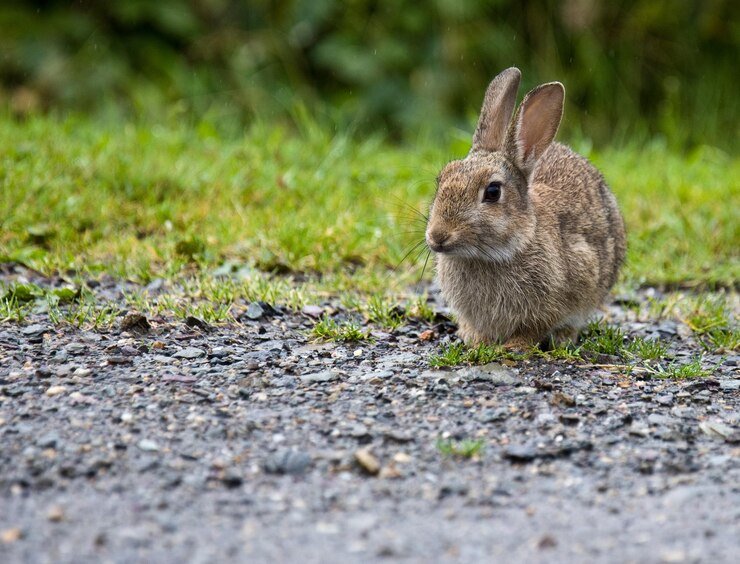If you’ve ever driven down a gravel road and noticed rabbits hopping around, you may have asked yourself, “What do rabbits eat from gravel roads?” The sight can seem odd, as these animals are often associated with grassy meadows, not gravel surfaces. The quick answer is that rabbits are not necessarily eating the gravel itself but are more likely searching for minerals, small plants, or even insects that may be present in or around the gravel. Now, let’s dive deeper into understanding why gravel roads attract rabbits and what they could be eating in such an environment.
Becoming Familiar with Rabbit Behavior
Well…rabbits are naturally curious animals, exploring their habitat for food sources and burrows to hide in. But how could they go for gravel roads, which are a far cry from their natural habitat?
A Safe Place from Predators
One reason could be safety. Gravel roadways, particularly in more rural or less-used locations give a flat surface area that searching rabbits can easily find danger coming from much along the roadway. While rabbits can be a prey to some predators, having open sightlines from hundreds of yards away makes for safe hopping in the Rocky Mountain backyard where I live.
Feeding On Gravel Roads
Food opportunities might also be unique to gravel roads. While rabbits are primarily herbivorous, they may find enough nutritional items like various plants, minerals, or other substances to meet their dietary needs. These roads often form the liminal space between humanified landscapes and wilderness, providing an interesting blend of native/non-native plant life and animal corridors for rabbits to follow.
What Do Rabbits Eat?
Before you learn what rabbits are eating from the gravel roads, it is important to know how they get their nutrients. As herbivores, rabbits are grass feeders and eat plant type materials. Typically, their diet includes the following:
Grasses
Grasses are the main dietary staple for rabbits. They are full of fiber which is an extremely important part of a rabbit diet. Grasses tend to have vital nutrients which ensure their teeth grow moderately as rabbits are on a constant level of chewing and grinding down the overgrowing teeth.
Leaves and Herbs
Rabbits also eat leaves, herbs, and other soft vegetation in addition to grass. These herbivores graze over a range of plants and pick the most nutritious, softest bits of them to snack on.
Bark and Twigs
During the winter months when fresh greenery is in short supply, rabbits frequently snack on bark and twigs instead. These ingredients give the rabbits fiber and nutrients.
Attraction Gravel Roads: The Treasure Hunt
With what rabbits eat in mind, let’s look at some things that these creatures are likely to be living off of using the gravel roads. Rabbits are unable to be able to eat gravel but will still visit these locations, so why?
Mineral Intake
The rocks in the gravel roads are generally small, and some can even be so enriched with minerals such as calcium or sodium. In the wild, rabbits turn to minerals as part of their intake. This is particularly crucial during the times when their normal food source like fresh plants are less. The rocks themselves may contain remnants of these minerals, which are vital for bone health and strength.
Rabbits might be licking or chewing the mineral-rich stones just in order to meet their dietary requirements for it. Some of the minerals that rabbits need may also be contained in gravel roads so it can act like a salt lick is used to provide deer with this kind of nutrients.
Many small plants sprouting on the road banks
You will often see gravel roads with bits of the living alongside. Those plants, such as dandelions and clovers may flourish in gravelly soil. Fresh, green vegetation is healthy for rabbits as they love to feed on well—kept garden plants with their tender leaves. Even some small weeds growing along the side of a road are enough to attract these animals.
Bugs and other minibeasts
Insects and small creatures that live in the gravel are among such attractions, aside from it being somewhere you might find rabbits. Although bunnies are herbivores, they will unknowingly eat little pests that are caught in the plant vegetation. The gravel roads can harbor a myriad of insects, worms, and little bugs that creep on the rocks. While not a major food source, they can still become part of the rabbit’s diet when other fodder sources are scarce.
Accidental Ingested Bugs
Now a rabbit isn’t going to actively hunt or eat insects, but let’s say that it is enjoying her food and also eating some small ants or beetles at the same time. Although more of a grazing side effect than an intentional dietary choice, the addition of bugs on gravel roads could small grid Nibblers in these types of habitats an attractive rabbit scent.
Harvesting Nutrients from the Unusual Sources
Because wild rabbits are opportunistic feeders, they will grab onto whatever food sources are available in trying times especially. Surely, gravel roads are probably the last place we expect highly nutritious bugs to hang out!
Behavioral Changes in Rabbits As the Seasons Change
Season — Rabbits get a variation in diet and might be up on gravel roads for other reasons too. They have various eating habits depending on the availability of food from season to season.
Spring and Summer
During the warmer months, when there is plenty of fresh vegetation available on which to graze, rabbits will generally be located closer to fields and gardens. But they may still come around to young shoots and plants that sprout up along gravel roads. All of the above list, especially weeds like dandelions provide a fast snack for rabbits on the go.
Fall and Winter
For the rabbits that are left uncaged or unattended, pushing over containers to nurseries and helping themselves freely as they chew on flowers of impatiens is something so common because in winter there will be no greens for them which means everything organic accept metallic objects would have been consumed! The minerals in the gravel roads and plants that grow on them might be easier to find perennially occurring as they are hardier. For many pathogens, their seasonal rarity likely drives rabbits to different types of foraging areas than other times in the year.
The Role of Habitat Loss
Human activity and and habitat loss are contributing reasons for why rabbits appear to be drawn toward gravel roads. As land in the area is cleared for houses and rainy-day forests, rabbits are pushed into smaller pockets of fragmented vegetation where they quickly run afoul of cars on gravel roads.
Shrinking Habitats
With less space available to them in the wild, rabbits will rub shoulders with human-made structures like gravel roads. These could become the last greens available to them as their natural grazing grounds recede, subject to various forms of human pressure.
Roads as Pathways
Rabbits have been known to use gravel roads as travel corridors, allowing them passage between disjunct grassland habitats. In rural settings where natural cover is scarce, these rodents sometimes use such roads leading to food largely as a way of getting out on the ground and away from predators.
To learn more about how wildlife corridors are affected by human activities and what can be done to maintain these vital pathways for plants, animals and people— visit the National Wildlife Federation’s page on Wildlife corridors at NWF Wildlife Corridors.
The Other Side: Wild Rabbit Nutrition, Why It Matters
Wild and domestic rabbits need a balanced diet to keep fit as well just the same with human beings and their food. The lack of any nutritional elements, such as fibers, proteins, or minerals can also cause serious health issues. When resources are scarce, such as often the case in summer or early spring up on Vegetation Hill where this was observed, these larger grazers expand their foraging range around gravel roads Gravel roads might offer wild rabbits access to minerals not readily afforded by their normal staple diet.
Calcium and Bone Health
Bone and teeth health (calcium): The most important mineral is calcium, it keeps rabbit bones strong. Gravel roads may provide small amounts of calcium through licking or nibbling the stones, in particular where there are natural salt deposits and mineral-rich stones.
Salt Intake
The other essential mineral, sodium is also a vital need that rabbits have to ensure healthy fluid levels and nerve functions. See the salt, this explains why rabbits want to lick on it! — Note: some of those roads are gravelly and may have only a little bit if any salt in them.
How to Keep Rabbits from Chewing on Gravel Roads
So, what is it the rabbits are eating on these gravel roads? Therefore, they are not biting the gravel itself but perhaps ingesting residue minerals as well as characteristic things such as small plants or insects in and also around the rocks. For the most part, rabbits will be able to work around a gravel road and get access to food but these animals are wild, not stupid so some thought needs to go into how we keep them safe on one side of a road while making sure they can engage with their habitat.
Use of Fencing
Putting up fencing on areas along gravel roads in parts of the landscape that primarily support rabbit populations can help keep them away from those dangerous roadways. This is especially useful if you live close to open land, and those rabbits are coming into your garden.
Avoiding Harmful Chemicals
Never apply poisons like pesticides or herbicides along gravel roads but it needs to do more and offer a written diagram of the restrictions. These are all toxic to rabbits, and other wildlife which may chew on them or the insects that live in amongst them.
Conclusion
In summary, rabbits are attracted to gravel roads primarily because of the minerals, small plants, and insects they may find there. These roads, though seemingly barren, offer a surprising range of food sources for rabbits, particularly when natural vegetation is scarce. By understanding what rabbits eat from gravel roads, we can better appreciate their behavior and take steps to protect them from the dangers of human-made environments.








